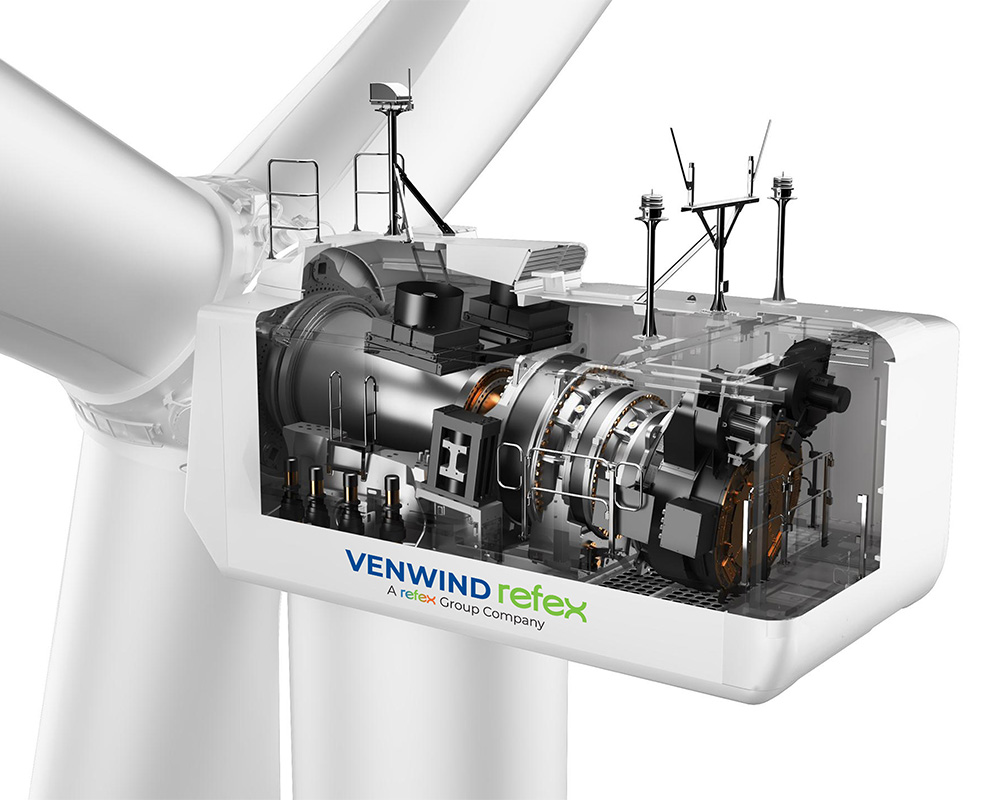Technology

Advanced Technology for Superior Performance
- Permanent magnet synchronous generator and full-scale power converter enables rapid dispatch response, more active power/frequency, reactive power/voltage control, and smoother fault voltage ride-through
- Reduced maintenance as a result of elimination of high-speed couplings and slip ring carbon brushes, cutting fault rates by 70% compared to DFIG wind turbines
Salient features
High Reliability
High Performance
High Scalability
Grid Friendly Connection
High Adaptability
High Safety
Technology Comparison
| Aspect | Vensys GWH182-5.3 PMG Hybrid technology | Gearbox wind turbines DFIG |
|---|---|---|
| Design concept | Optimized design strategy to get advantage of permanent magnet generator at medium speed | High speed generator and moving parts |
| Reliability | Higher reliability due to medium speed | More prone to mechanical failures due to high speed |
| Maintenance | Lower maintenance costs | Higher maintenance costs and regular up keep for high-speed gearbox and other components |
| Efficiency | Higher efficiency due to lower losses | Energy losses due to high temperature operations |
| Noise Level | Quieter operations | Noisier due to high speed operation |
| Grid Friendly | Active & Reactive power control and LVRT & HVRT | Challenges of maintaining power factor and LVRT & HVRT |
| Cost | Lower LCOE during project lifetime | Higher LCOE due to higher operational expenses and lower turbine efficiency |
Technical Advantages
Adaptable to random changes in wind, optimizing power output
Adaptable to random changes in wind, optimizing power output
- Higher wind energy utilization, minimal energy loss and less maintenance (low speed)
- Optimized technology giving advantages of both permanent magnet generator and low-speed drive train
- Active air-cooling system for generator and drive-train ensures high
performance and reliability
Automatically corrects wind vane orientation for improved wind alignment accuracy
- Outstanding fault ride through capability and grid friendliness (AC-DC-AC
conversion) - Full power converter is cooled by active liquid cooling system, effectively improving the cooling efficiency
Redundancy design for high reliability
Regularly detects ultra capacitors of the pitch system, reducing risk to the wind turbine
Enables flexible installation and construction
Facilitates easy commissioning and stable operation
Central, remote, and online monitoring systems for efficient operation and maintenance
Advantages over Competitors
Permanent magnet medium speed technology
Permanent magnet medium speed technology
Captures more wind energy, higher tip speed ratio
Supports enhancement to higher capacity and higher rotor diameter
Designed to operate at higher capacities (4.8MW and above)
- Operates at a constant power factor, independent of grid voltage
- No need for external grid excitation
Cut-in wind speed 2.5m/s
Other Benefits
- Higher wind energy utilization and adaptability
- Large rotor diameter and higher hub height for its class
- Lesser BOP and O&M costs due to larger size resulting in improved LCOE
- Higher wind energy utilization and adaptability
- Large rotor diameter and higher hub height for its class
- Lesser BOP and O&M costs due to larger size resulting in improved LCOE
Optimized design strategy to get advantage of permanent magnet generator at medium speed
Medium speed Gearbox (MSPM) design ensures minimum maintenance and high reliability
German technology with more than 2GW installations of the 5.3MW WTG platform worldwide by Vensys technology partners


